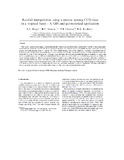Rainfall interpolation using a remote sensing CCD data in a tropical basin – A GIS and geostatistical application
Date
2007Author
Moges, S.A.
Alemaw, B.F.
Chaoka, T.R.
Kachroo, R.K.
Publisher
Elsevier, www.elsevier.com/locate/pceType
Published ArticleMetadata
Show full item recordAbstract
This paper is aimed at developing a geostatistical model to improve interpolated annual and monthly rainfall variation using remotely-
sensed cold cloud duration (CCD) data as a background image. The data set consists of rainfall data from a network of 704 rain
gauges in the Rufiji drainage basin in Tanzania. We found ordinary kriging to be a robust estimator due mainly to its inherent nature of
including the non-stationary local mean during estimation. Parameter sensitivity analysis and examination of the residuals revealed that
the parameter values of the variogram viz., the nugget effect, the range, sill value and maximum direction of continuity, as long as they
are in acceptable ranges, and any different combination of these parameters, have low effect on model efficiency and accuracy. Rather, the
use of remotely-sensed CCD data as a background image is found to improve the interpolation as compared to the estimation based on
observed point rainfall data alone. The study revealed the improvement in terms of Nash–Sutcliffe model performance index (R2) by
using CCD as external drift with kriging provided an R2 of 64.5% compared to the simple kriging and ordinary kriging, which performed
with efficiency of 60.0% and 61.4%, respectively. For each case, parameter sensitivity analysis was conducted to investigate the effect of
the change in the parameters on the model performance and the spatio-temporal interpolation results.

